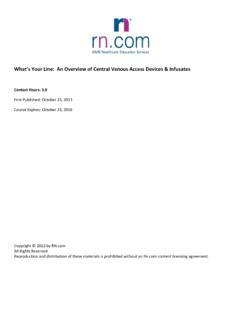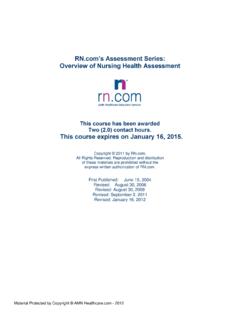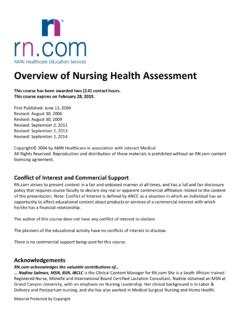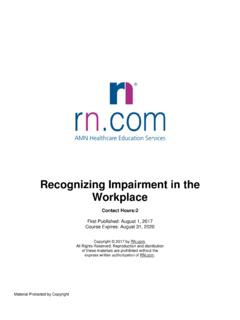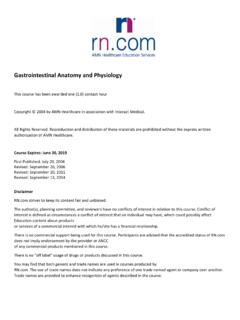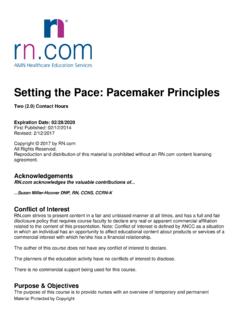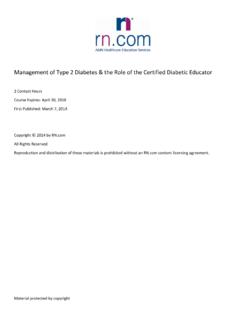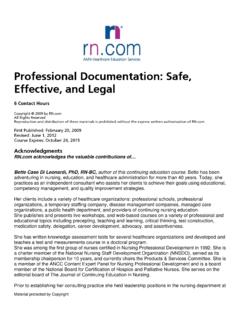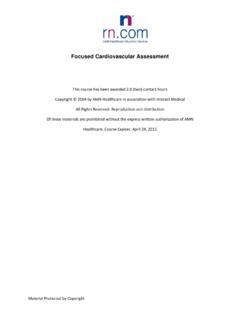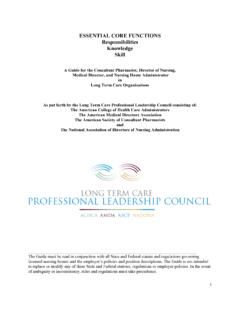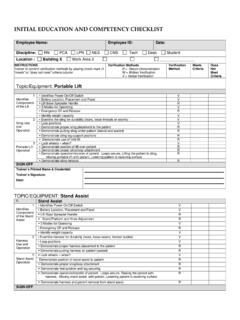Transcription of Chest Tube Management 2013 PV - RN.com
1 Chest Tube Management Two ( ) Contact Hours Course Expires: 12/31/2020. First Published: 08/30/2007. Updated: 08/30/2010. Updated: 11/01/2013. Reproduction and distribution of these materials is prohibited without an content licensing agreement. Copyright 2013 by All Rights Reserved. Acknowledgments acknowledges the valuable contributions .Nadine Salmon, MSN, BSN, IBCLC is the Clinical Content Manager for She is a South African trained registered nurse , Midwife and International Board Certified Lactation Consultant. Nadine obtained an MSN at Grand Canyon University, with an emphasis on Nursing Leadership. Her clinical background is in Labor & Delivery and Postpartum nursing, and she has also worked in Medical Surgical Nursing and Home Health.
2 Nadine has work experience in three countries, including the United States, the United Kingdom and South Africa. She worked for the international nurse division of American Mobile Healthcare, prior to joining the Education Team at Nadine is a nurse planner for and is responsible for all clinical aspects of course development. She updates course content to current standards, and develops new course materials for ..Shelley Lynch, MS, RN, CCRN, contributing author of Chest tubes . Shelley has over 10 years of critical care nursing experience. She completed her Bachelors of Science in Nursing from Hartwick College and her Masters of Science in Nursing with a concentration in education from Grand Canyon University.
3 Shelley worked in a variety of intensive care units in some of the top hospitals in the United States including: Johns Hopkins Medical Center, Massachusetts General Hospital, New York University Medical Center, Tulane Medical Center, and Beth Israel Deaconess Medical Center. She is the author of 's: Diabetes Overview, Thombolytic Therapy for Acute Ischemic Stroke: t- PA/Alteplase, ICP Monitoring, Abdominal Compartment Syndrome, Chest Tube Management , Acute Coronary Syndrome: A Spectrum of Conditions and Emerging Therapies, Mechanical Ventilation, Procedural Sedation & Analegsia and Pulmonary Artery Catheter & Hemodynamic Values. Shelley is a member of the American Association of Critical Care Nurses (AACN) and National League of Nursing (NLN).
4 She was inducted in Sigma Theta Tau International Honor Society. She is currently Material Protected by Copyright an Advance Cardiac Life Support (ACLS) and Basic Life Support (BLS) Instructor. She has her Critical Care registered nurse (CCRN) and her Trauma nurse Core Curriculum (TNCC) certifications..Kelly Muck, MPH, contributing author of Chest tubes . Conflict of Interest strives to present content in a fair and unbiased manner at all times, and has a full and fair disclosure policy that requires course faculty to declare any real or apparent commercial affiliation related to the content of this presentation. Note: Conflict of Interest is defined by ANCC as a situation in which an individual has an opportunity to affect educational content about products or services of a commercial interest with which he/she has a financial relationship.
5 The author of this course does not have any conflict of interest to declare. The planners of the educational activity have no conflicts of interest to disclose. There is no commercial support being used for this course. Purpose & Objectives The purpose of Chest Tube Management is to understand the use of Chest tubes and the conditions that require their use. This course is designed to provide healthcare professionals with information about Chest tubes and the Management of Chest drainage systems. After successful completion of this course, you will be able to: 1. Identify indications for the use of Chest tubes and accompanying signs and symptoms. 2. Describe the risks/complications associated with Chest tubes and Chest drainage units (CDUs).
6 3. Identify how to prepare/assist with the insertion of a Chest tube. 4. Describe the monitoring of Chest tubes and Chest drainage systems. 5. Describe considerations in caring for the patient who has a Chest tube, including Chest tube maintenance. 6. Identify factors that indicate when it is appropriate to discontinue the use of a Chest tube. 7. Describe how to assist with discontinuation of a Chest tube. Introduction Breathing is automatic. We don't usually think too much about it unless we develop a problem. Lack of adequate ventilation and impairment of our respiratory system can quickly become life-threatening. Healthcare professionals need to understand the basics of pulmonary function.
7 When interventions such as Chest tube placement may be required to sustain life, it is essential that the healthcare professionals that provide care for these individuals have a strong understanding of pulmonary pathophysiology and factors that can influence the mechanics of effective air exchange. It is also important that the healthcare professional understands the risks associated with Chest tube insertion and drainage. Healthcare professionals also need to know how to assist with the preparation of the Chest drainage unit, perform ongoing patient assessments, document appropriately, and troubleshoot possible problems related to the use of a Chest tube. Material Protected by Copyright Definitions Pneumothorax: A collection of air in the pleural space.
8 Note that pneumothorax is the most common serious pleural complication in the Intensive Care Unit & the most common reason for inserting a Chest tube. Tension pneumothorax: Occurs when air accumulates in the pleura space to the point of causing a mediastinal shift pushing the heart, great vessels, trachea, and lungs toward the unaffected side of the thoracic cavity. Hemothorax: A collection of blood in the pleural cavity. Hemopneumothorax: An accumulation of both air and blood in the pleural cavity. Pleural effusion: Is excessive fluid in the pleura cavity. Chylothorax: Is the accumulation of lymphatic fluid in the pleural space. Empyema: Is a collection of purulent material from an infection like pneumonia.
9 Signs and Symptoms of a Tension Pneumothorax include: Severe respiratory distress Tracheal deviation toward the unaffected side Cyanosis Muffled heart sounds Cardiac arrest Material Protected by Copyright Pleuropulmonary Anatomy, Physiology & Pathophysiology A review of basic pleuropulmonary anatomy, physiology, and pathophysiology is necessary to facilitate a comprehensive understanding of Chest tubes . Pleural space: it is the cavity between the membrane lining of the lungs (visceral or pulmonary pleura). and the lining of the Chest cavity (parietal pleura). The pleura space functions to: Prevent friction between the outer lining of the lung and the inner lining of the thoracic cavity during respiration.
10 Hold the two pleural surfaces together, creating negative pressure (a vacuum) that keeps the lungs expanded (Coughlin & Parchinsky, 2006). The lungs are elastic and naturally tend to collapse or recoil, but in normal conditions, the pleural space causes the outer lining of the lung to adhere to the lining of the Chest cavity, keeping the lungs expanded to proper position during inspiration and expiration (Roman & Mercado, 2006). The pleural space is normally filled with approximately 50 mL of fluid, only enough to essentially provide a thin coating of fluid for the lubrication of the opposing surfaces. Small increases in volumes of air and/or fluid can be absorbed by the body, whereas larger volumes prevent the lung from expanding to its full potential.
